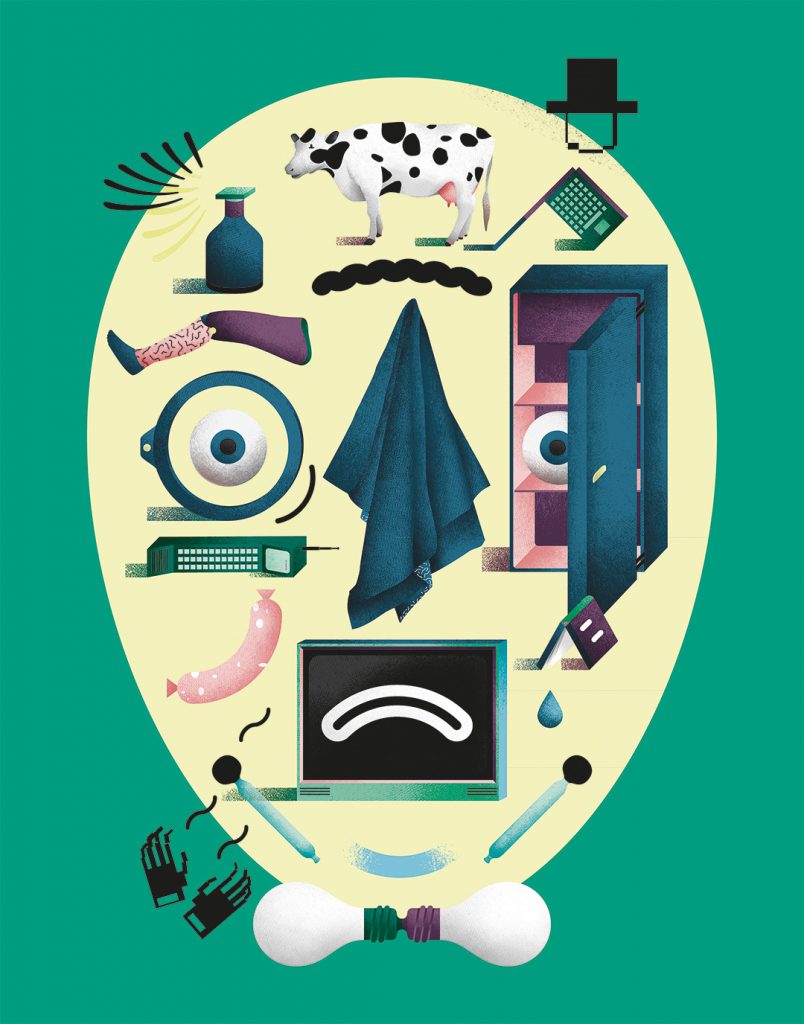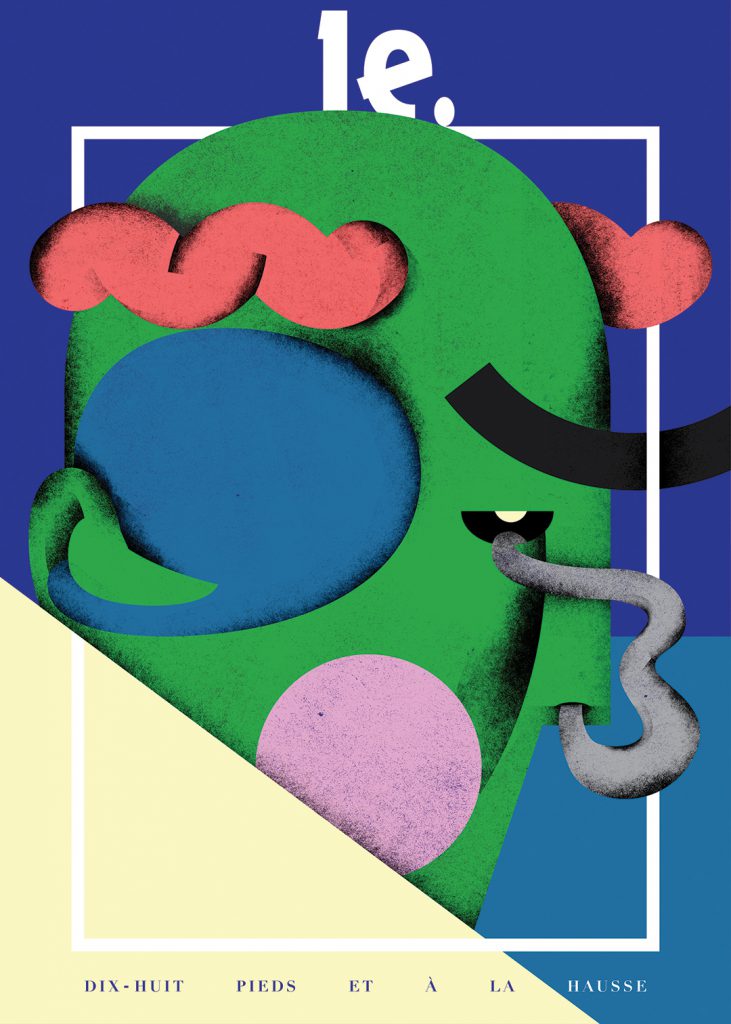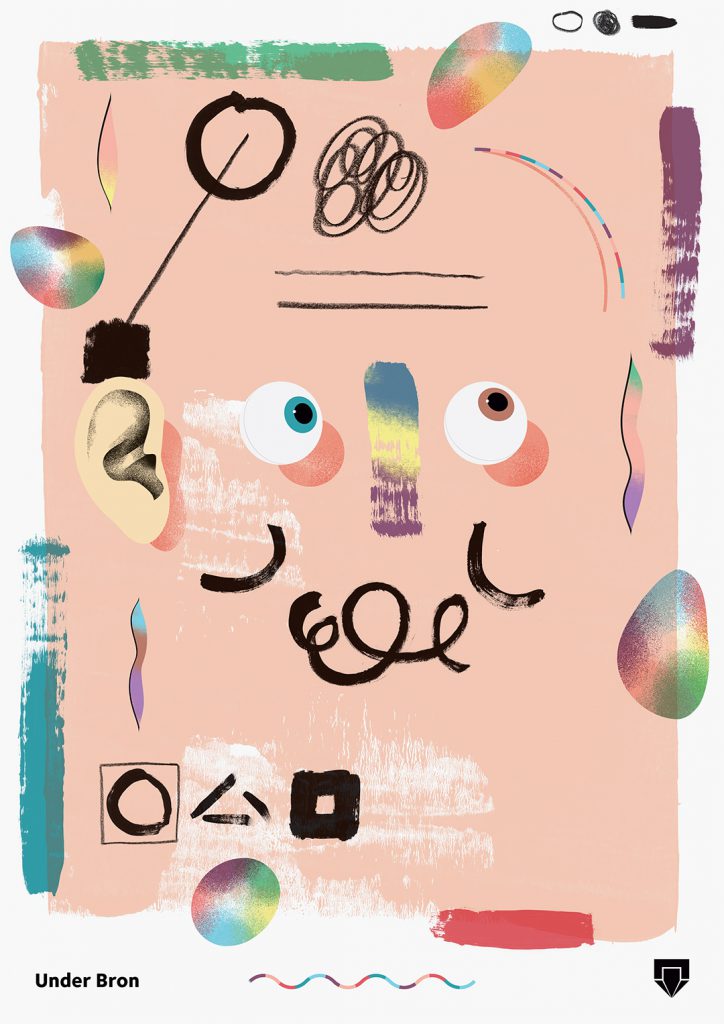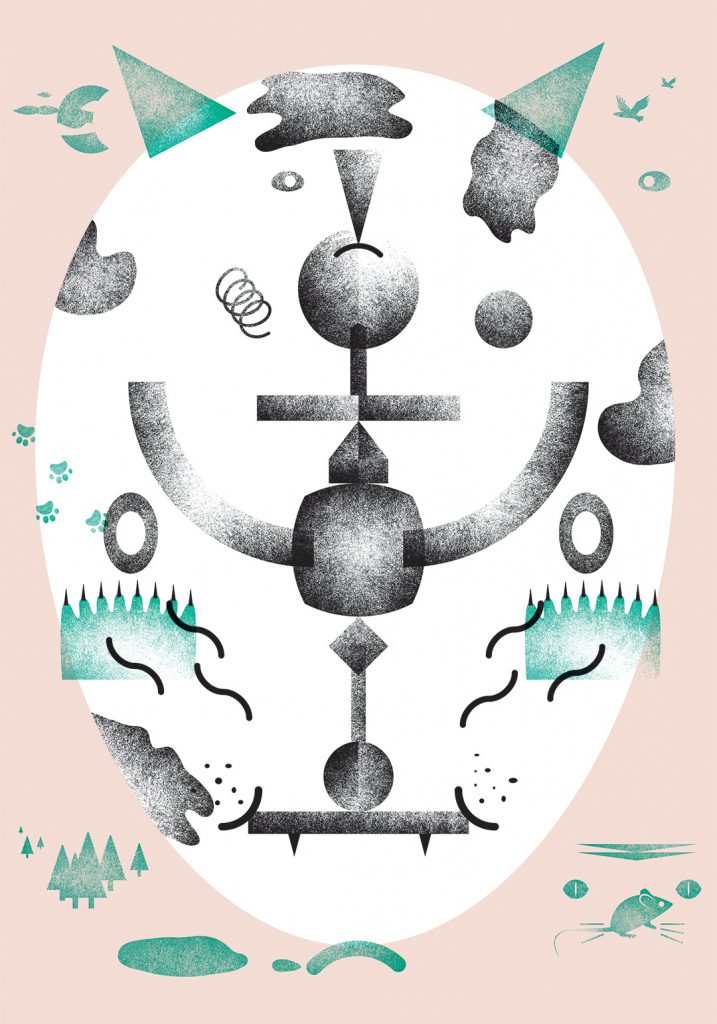Martin Nicolausson
Interview by Ana Cabral Martins

Martin Nicolausson is a Swedish illustrator and graphic designer whose work has been exhibited world-wide. He begins his online bio by saying that he may be the only person in his fi eld named ‘Martin Nicolausson’ and that it is incredibly important for him to be, and stay, original. Martin views himself first as a graphic designer and second as an illustrator. He moved to London by choice, and his artistic style is deemed dark, but playful and quirky. He works between analog and digital form, between inspiration from the past and aspirations for the future.
A. How does being Nordic/Swedish affect the way you approach your work? Is there a Nordic aesthetic? And if so, how do you fit into it?
M. There surely is a Nordic aesthetic; it has something to do with clean lines and a minimalist approach. I don't feel very much a part of that tradition, even though it is still going quite strong throughout educational institutions here. I think it affected me more when I went to school.
A. Where did you grow up? What was your childhood like?
M. I grew up on a small island in the center of Stockholm, which is comprised mainly of islands of varying sizes anyway. It was kind of like growing up out in the country and in the city at same time. I had a rather normal childhood.
A. Did your artistic nature reveal itself early on?
M. I did like to draw, but I think most kids do. I wasn't a whiz kid at drawing or anything. I also played the drums for a while.
A. How is a typical day in your life?
M. I try to wake up early and fail miserably; I then usually have some porridge for breakfast. Take a short walk to the studio, work on what needs to be worked on, go home and spend some time doing things that aren't related to work. Like having dinner or seeing a movie, hanging out with friends or doing what people in general do in their spare time.
A. What tools do you use when working?
M. Almost exclusively my laptop. Sometimes paint and brushes.
A. After working for the New York Times, do you have a favorite magazine, newspaper you would like to work in the future?
M. Cover of Time?
A. Does the comic book aesthetic influence your own work?
M. I've never been a big comic book fan, so no, not consciously anyway.
A. How is it working for clothing lines like Monki or Topman? Does the difference in scale—being Monki a lesser-known brand—mean more creative freedom? How did Monki marry with your aesthetic? Do you try to provide your employer and your work with your personality, or do you choose clients that share, in advance, your bold aesthetic?
M. I wish I could choose clients! That would be pretty cool. But usually, no, they come to me. In the case of Monki I think they saw a connection in what I was doing with the visual language of the brand. I had a lot of freedom, which makes injecting some personality into the work so much easier; I always try to do that but in some cases when an illustration goes through who knows how many rounds of amendments will happen...it might end up being nothing like what I would have chosen to do initially. Rarely this will be a good thing, but it does happen. The Topman commission came through Povilas Utovka, with whom I shared studios in London. It was a collaborative effort, something I'd like to do more.
A. Both Topman and Monki have asked you to do projects in Asian cities—Topman in Tokyo, Monki in Nanjing—how do you feel your aesthetic works within Asian culture? Are you influenced by it?
M. I guess my aesthetic in some cases would work well in Asian countries, but I can't say I'm hugely influenced by Asian culture. Probably because I haven't spent enough time there. It's a market that I would really like to tap into.
A. What is your relationship with technology like?
M. It's impossible not to have a relationship with technology today; mine is love-hate. It enables me to do what I do, but it also enables compulsory procrastination. I'm very much interested in what the future will bring. Technology-wise however, I kind of envision a Blade Runner-like scenario. Or 2001: A Space Odyssey, it's my favorite movie.
A. Who would be your ideal client?
M. Huge budgets, big freedom, endless exposure. Hehe.
A. What was your most rewarding job?
M. I like working on personal projects, so probably one of those. The most fun commission I worked on was probably for Monki, as it was applied on so many varying scales and I was given free rein within the brief, more or less.
A. On your website, you start your biography by saying no one in Sweden has your name, which is akin to originality, which you consider important. Could you elaborate on that?
M. My bio was written by Matt Keon who is a CD at 18 Feet & Rising in London. I'm not that great with words. But I do value originality; something I find is getting scarcer.


A. How does the relationship with the past and analog shape your work?
M. My biggest influences are all artists that would use analog mediums. I'm a very nostalgic person. I like the idea of tapping into these old ways of doing things, to transition that into present day technology. I do think it's important for artists to undergo some sort of traditional training. Life drawing isn't available as a Photoshop tutorial.
A. Do you equate the future with digital? How does your work reflect your vision of the future?
M. Not necessarily, future societies will surely be highly digitalized but when it comes to creating, I think there will always be a desire for analog. That has hardly changed since we lived in caves; can't see it will in the future. When it comes to the reach of art and how we look at and exhibit art, now that's an entirely different story. I don't whichever tools come naturally to me.
A. How did your path to illustration come about?
M. I graduated from design college in 2008; I was set on working mainly as a graphic designer but realized, after some time, that illustration was a more plausible path for me to take. I still do graphic design though and enjoy it very much. I started out as a freelancer straight out of college; don't know if I would advise anyone to do that but it's worked out quite well for me. Worked in Stockholm for a while and then moved to London for a few years, which was really good work-wise.
A. What are the major influences for you work?
M. They vary a lot, but I keep coming back to the art of Picasso, Miró, Matisse and Hopper.
A. Are you often portrayed as an abstract, surrealist, cubist artist?
M. I'm not sure...surrealist? Maybe.
A. What is your creative process like?
M. Get briefed (usually), think about the brief, start work, think some more, create lots of things, move them around and then take things off until I'm happy with the result. Or something entirely different.
A. What does it mean for you to be an artist?
M. It's my livelihood, so to me it's just what I do. But, of course, I feel happy to be able to make a living of my favorite hobby in the world.
A. Tell me more about the Graminator: did you enjoy working on an app? How did it come about? How different was that from working on Monki’s app?
M. It's always good to see your work being applied to new things. My Granimator pack was 100% me, the concept and everything. For Monki I had a list of things to do, which is of course usually the case when working on a paid commission.
A. Are you interested in continuing to work on apps for iPhone and iPad? How does that correlate with your artistic vision?
M. Sure, I like how it allows people to interact with my work in other ways than to just look at it. It would be great to be part of creating an app from the ground up and not just do the art.

A. How does your more artistic, exhibition-related work relate to your more commercial, client driven work? Do you see a difference, and do you mind it?
M. The personal projects are what drive my commercial work forward; they allow me to try new things out, which can subsequently be applied to the commercial side of things. It's always a struggle to balance things between commissions and personal work, the former always take priority as they pay my bills and at times there is just no time left to think about personal work. It gets me down, but it’s just part of working commercially I guess. I really enjoy that too, but sometimes there needs to be more balance.
A. What is your relationship with food—and your work—like?
M. I've just ended up doing lots of food-related stuff for no particular reason other than happenstance. I enjoy food as much as the next guy, but it's not a huge interest of mine or anything. However, there is something interesting about how some foodstuffs have become almost icon-like. A sausage is almost like a logo. I like that.
A. How well do you work with other artists?
M. I would like to be better at collaborating, but I'm kind of a control freak. I should try it more often.
A. What is your relationship with fashion? How do you view personal style?
M. I enjoy nice clothes, but don't really use them as self-expression. I really like what some fashion houses are doing, communication-wise, like Prada and lately, Kenzo.
A. What is/was your favorite place to exhibit in?
M. I'd like to do a solo show on the Moon.
A. What was the exhibition that most stuck with you while growing up?
M. I remember seeing Dali's Enigma of William Tell at age five or something and being blown away by it.
A. What are some of your favorite Nordic artists? And international?
M. Different people from day to day.
A. What is your relationship with music like, does it influence your work? Who are some of your favorite musicians?
M. Music definitely influences my work in some way, as I listen to it all the time. I listen to everything and I throw away way too much money on discogs.
A. Why do you end you biography (on your website) by saying you wish to show “less of the Martin, more of the Nicolausson”? Could you elaborate on that?
M. II think what Matt was saying was that I want to bring out more of the surname part of my name. Everyone knows Martin but hardly anyone can pronounce Nicolausson.

A. Are you still based in London? Does the city influence your work? Do you miss Sweden?
M. I moved back to Sweden last year. I miss London.
A. You have stated that you primarily prefer to work in black and white. Why is that? Does your process differ when working with color? How do you hone in on a color pallet?
M. It clearly doesn't apply to my work anymore...that whole philosophy I had...if I ever had one...about working in black and white..., which has been turned upside down as I use a lot of colors nowadays. I don't feel it has changed my process much either. I just choose whatever colors I like. I usually start out with lots of them and then narrow my selection down until they make sense appearing next to each other.
A. Do you see yourself as, first and foremost, a designer or an illustrator? What is your relationship with typography?
M. I started out as a designer and I'm still very fond of typographical work. I would say I'm half designer and half illustrator, or an illustrator with a designer's outlook. Thinking in graphic design terms is what really drives my work.
A. How do playfulness and a sense of humor work into your drawings?
M. I try not to take myself too seriously. Humor is a great way of accomplishing that.
A. Do you see your work as a composition of textured parts? How does texture influence your work?
M. It's definitely a big part of my work, yes. A composition of textured parts is actually a pretty good way to put it. I work with textures from the get-go most of the time, so they’re really incorporated into my work, not something I add when everything else is done.
A. Can you tell me more about your “Doors” project?
M. I wanted to elaborate on a chain of thoughts I had about doors in general and how much of the world is locked away from us. It's frustrating not to have access to everything; I love entering new buildings and rooms, seeing what's being kept in previously inaccessible places.
A. Do you believe your work has some amount of quirkiness?
M. I hope so.
A. Does cinema influence your work?
M. I love cinema but I can't say it directly influences my work. Good cinema surely influences my thinking so it's probably sneaking in there somewhere.